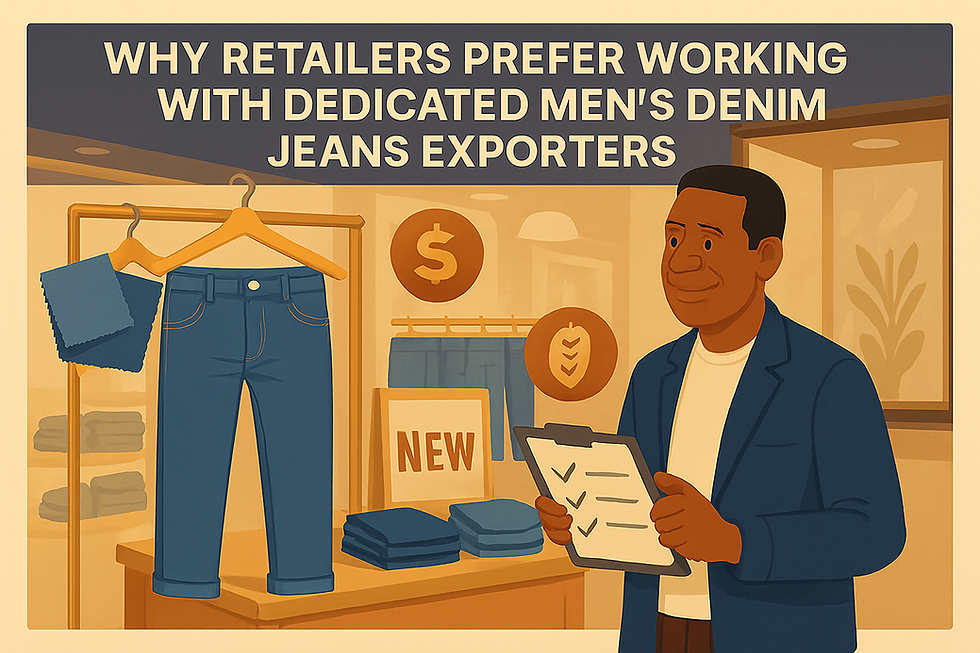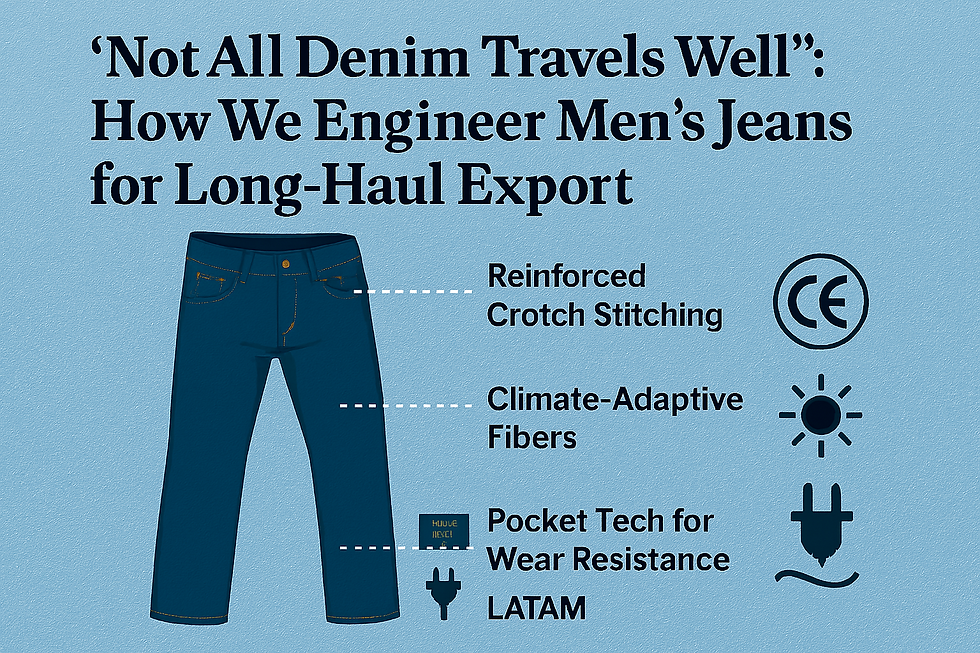Want to Launch a Denim Brand? Here’s What No One Tells You About Wholesale
- jlintlco
- Sep 9
- 4 min read

Launching a denim brand in 2025 is an exhilarating venture. With the global denim market projected to hit $151 billion this year, growing at a CAGR of 4.8% through 2032, there's immense potential for innovative labels blending sustainability, style, and comfort. Picture your custom washes on high streets or e-commerce feeds, tapping into trends like relaxed fits and eco-friendly fabrics. But here's the reality check: Wholesale—the backbone of scaling from prototype to profit—comes with hidden hurdles that can sink even the most creative startups. While gurus tout design and marketing, few discuss the gritty wholesale truths: punishing MOQs, ethical supplier dilemmas, tariff traps, and sustainability mandates that demand more than greenwashing. As a new entrant, ignoring these could cost you thousands in wasted inventory or lost partnerships. Drawing from industry insights, this blog uncovers what no one tells you about denim wholesale, equipping you to launch smarter.
The Allure and Pitfalls of Wholesale for New Brands
Wholesale is your gateway to volume sales, allowing retailers like Urban Outfitters or online giants to stock your line without you handling fulfillment. For denim, where production involves resource-intensive processes like dyeing and distressing, wholesale spreads costs across larger runs. Yet, for startups, it's a double-edged sword. Established brands like Levi's dominate, leaving newcomers scrambling for shelf space amid fierce competition.
One unspoken challenge: Minimum Order Quantities (MOQs). Manufacturers often demand 500-1000 units per style to justify setup costs, but as a fledgling brand, committing to that can tie up $50,000+ in capital before you've sold a pair. If trends shift—say, from skinny to baggy— you're stuck with dead stock. No one warns you that negotiating lower MOQs requires leverage, like promising repeat business or paying premiums. Start small by partnering with flexible suppliers in Turkey or Mexico, where MOQs can dip to 200 units, but expect higher per-piece prices. Tools like Alibaba help scout, but vet rigorously—fake reviews abound.
Supplier Relationships: The Ethical Minefield
Finding wholesalers isn't just about price; it's about ethics and reliability. A 2025 report highlights a disconnect: Brands demand fair labor from suppliers but often squeeze them with late payments or unrealistic deadlines, eroding trust. For new denim brands, this means auditing factories for BSCI or Sedex compliance to avoid scandals like those plaguing fast fashion. No one tells you that "sustainable" claims are often hollow—water-intensive denim production guzzles 7,000 liters per pair, and suppliers may cut corners on eco-dyes to meet your budget.
Build relationships early: Visit factories (virtually if needed) and start with samples. Reddit entrepreneurs advise local agents for oversight, preventing quality dips like uneven fades or weak stitching. Hidden cost: Currency fluctuations. Sourcing from Bangladesh might save 20% upfront, but tariffs or forex swings can erase gains. In 2025, US trade shifts add 10-25% duties on imports from China, pushing brands toward nearshoring in Central America. Factor in lead times—12-16 weeks standard, but delays from raw cotton shortages (up 15% this year) can derail launches.
Sustainability: Non-Negotiable, But Costly
Consumers crave green denim—recycled cotton, organic dyes—but wholesalers often charge premiums for these. A major myth: "Sustainable" is easy. Rethinking denim from fiber to finish demands investment in low-water tech like laser distressing, adding 10-20% to costs. For startups, this means balancing ideals with reality; skip certifications like GOTS initially, but plan for them as retailers like Nordstrom demand proof.
No one mentions the circularity push: By 2030, EU green legislation requires recyclable materials, forcing wholesalers to adapt or lose business. Tariffs on non-eco fibers threaten progress, so source from innovators like Jeanologia for ozone washes that cut water use by 95%. Tip: Start with private-label suppliers offering ready templates, customizing washes to your brand without full R&D costs.
Logistics and Hidden Fees: The Silent Killers
Wholesale logistics can devour margins. Freight from Asia averages $5-10 per unit, but 2025's geopolitical tensions spike rates 20% due to Red Sea disruptions. Duties, VAT, and brokerage fees add another 15-30%, often overlooked in budgeting. Use Incoterms wisely—opt for FOB to control shipping, avoiding surprises.
Quality control is another blind spot. Remote inspections via apps like QIMA are essential, as defects hit 5-10% in bulk runs. Returns eat profits, so negotiate warranties. For sales, platforms like Faire or NuOrder simplify B2B, but fees (5-15%) cut into your 50-60% wholesale markup.
Marketing Your Wholesale Line: Beyond the Hype
Wholesale success hinges on visibility. Trade shows like Kingpins are goldmines, but booths cost $5,000+, and no one says follow-up is key—nurture leads with samples. Digital tools: Launch a B2B site with 3D previews, and use social for storytelling. Target niches like athleisure denim for differentiation.
Essential Tips to Navigate Wholesale
Business Plan First: Outline finances, target market (e.g., Gen Z for baggy low-rises), and projections. Aim for 30-40% margins post-costs.
Prototype Smart: Use local tailors for initial runs before scaling.
Diversify Suppliers: Don't rely on one—mix for risk mitigation.
Legal Basics: Trademark your brand; understand contracts to avoid IP theft.
Scale Gradually: Start DTC to test, then pivot to wholesale.
Conclusion: Launch with Eyes Wide Open
Launching a denim brand via wholesale is rewarding but ruthless. The market's growth masks challenges like high MOQs, ethical sourcing, and tariff turbulence that can bankrupt unprepared founders. By prioritizing relationships, sustainability, and data-driven decisions, you can thrive. Remember, success stories like Indigofera started small, focusing on quality over quantity. Arm yourself with knowledge, budget conservatively, and your brand could redefine denim. Ready to stitch your future?






Comments